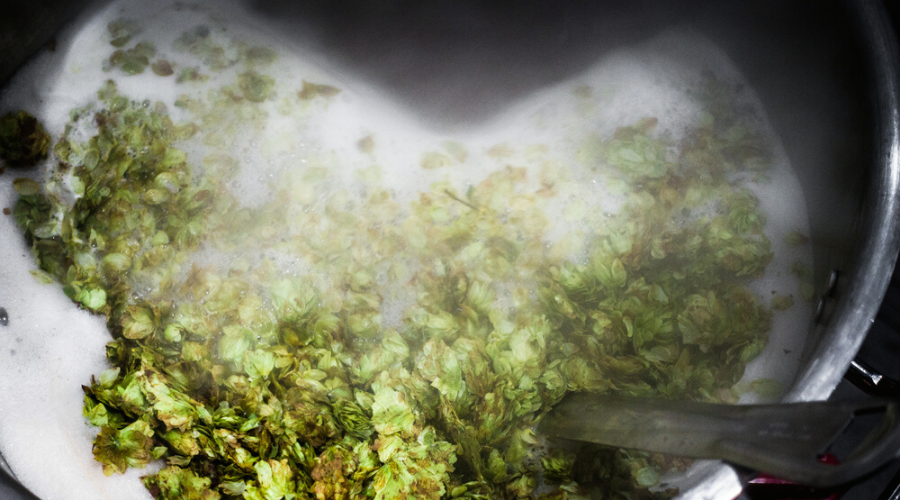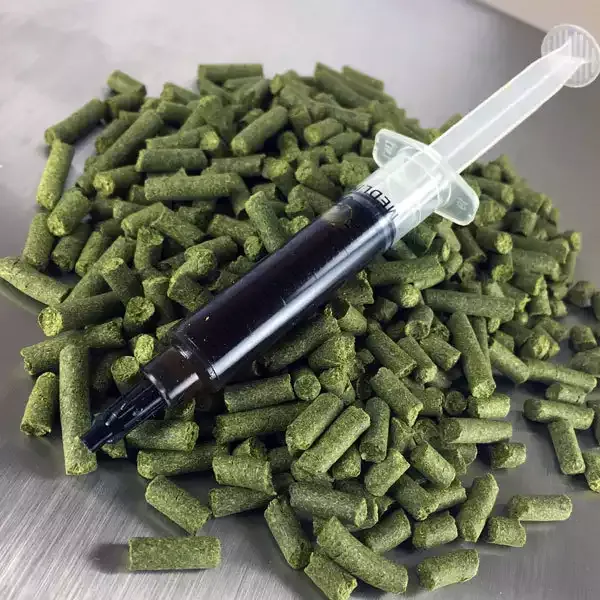
First wort hopping was lost for decades, before being rediscovered in 1995. It’s a simple technique to try out and could have major benefits.
First wort hopping consists of adding hops to the boil kettle as it heats from mash temperature to boiling. The extra time creates a stronger hop aroma, a smoother bitterness, and a more complex hop flavor.
Not everyone agrees that first wort hopping, or FWH, makes a difference. Because it’s so easy to try, it’s worth experimenting for yourself to see if it works for you. We’ll run down the pros and cons in this guide and give you tips on how to first wort hop your own beer.
Editor’s Note: Not even everyone here at Bison Brew agrees that FWH is worth the trouble.
What is First Wort Hopping?
For most homebrewing purposes, hops don’t matter until your wort is boiling. Then you add all your hops on a schedule to maximize their bittering and aromatic qualities. First wort hopping strays from that formula a bit.
When you do FWH, you add a part of your hops when you transfer the wort into the boil kettle. It remains in the kettle as you heat the wort to boiling, and throughout the standard boil time.
The idea is to create a different kind of bitterness: more smooth with less bite. It also has the pleasant side effect of avoiding your boil kettle erupting when you add your first hop addition!
Who Invented First Wort Hopping?
Short answer: we don’t know. First wort hopping was very popular in the late 1800s and early 1900s, so it’s not a new invention. Like a lot of brewing techniques, it was probably discovered by experimentation.
In the mid-1900s it began to drop off in popularity. It almost entirely disappeared until 1995. Then Brauwelt published a report called “The Rediscovery of First Wort Hopping.” We’ll go into the report in more detail later, but this study is why FWH is known today.
The Science of First Wort Hopping
Hops are generally split into two components: their alpha acids and their oils. Usually, hops added at the beginning of the boil are high in alpha acids, as the oils are volatile and will boil off.
When the hops are added before the water is boiling, the oils turn into more soluble compounds. This means more of them stay in the wort after the boil. The more oils that are retained, the more hop aroma remains in the beer.
Another common effect from FWH is a smoother, more harmonious bitterness. The science behind that isn’t fully understood, but it has to do with the one of the main alpha acids found in hops.
Cohumulone is the alpha acid that imparts the harshest bitterness to beer. Wort that is first wort hopped has a lower amount of this compound. The reason why isn’t well understood, but may have something to do with the lower pH that the hops are subjected to.
Is First Wort Hopping Effective?
So much of brewing is steeped in myth and oral tradition. A beautiful part of this hobby is learning what’s a good idea and what’s not based on what people around you have tried and experienced.
As we’ve modernized the process, however, it’s become clear that some recommendations are…junk. Sometimes even the most respected brewers in homebrewing are wrong.
First wort hopping, much like other brewing techniques, is hotly debated. Does it make a difference? If so, how much? We’ve gathered the research of experts in the field so you can make a decision for yourself.
The Experts
Plenty of the top names in homebrewing support FWH. John Palmer explains in How to Brew the benefits of first wort hopping. Gordon Strong insists that the hop flavor of his beer is more complex and smoother with first wort hopping in Brewing Better Beer.
The experts are brilliant, but they’re also completely anecdotal. The good news is that a lot of people have done a lot of research on the topic of FWH. These include chemical analysis and blind taste testing.
The bad news is that a lot of this research is contradictory. We’ve laid it all out for you, but we recommend you try the technique yourself and see what you think. It’s so easy that there’s no downside.
Brauwelt
The research published in Brauwelt in 1995 revitalized first wort hopping. Two breweries conducted the study by brewing two identical pilsners each. One was first wort hopped and one was not.
The overwhelming majority of the taste testers preferred the first wort hopped pilsners. They were described as having a more uniform bitterness. However, chemical analysis showed that the first wort hopped beer had more IBUs than the control.
The first wort hopped beers also had completely distinct aromatic compounds. This lends credence to the tasters’ claim that it had a stronger hop aroma. This research kicked off first wort hopping as a modern practice.
ExBEERiment and Oregon Brew Lab
The Brulosophy blog publishes a regular experimental series called exBEERiments. They brew two beers that only differ in one variable. Then they give the beers to tasters in a blind triangle test to determine if they can pick which is different.
Brulosophy has done trials on first wort hopping twice. Both times they compared FWH to hopping at 60 minutes. Their first experiment included 39 tasters. Only 15 of them could pick out the different beer. This is barely more than random chance guessing would result in.
In their second experiment, they went through the same process. This time, 7 out of the 21 tasters chose the right glass, the number you’d expect from random guessing. On top of that result, they also sent their beers to the Oregon Brew Lab for IBU analysis.
In the analysis, they found that the first wort hopped beer was slightly more bitter than the control. This was surprising since they tasted the same. Most of the results were against first wort hopping, but this raised more questions.
Oregon State University
In 2017, a professor and student at Oregon State University brewed two beers. One was first wort hopped and one not. They then ran those beers through a full chemical analysis.
They found that there was no sensory differences in the beers whatsoever. The analysis did reveal a slight difference between the two, though. The first wort hopped beer had a higher amount of polyphenols in it.
Polyphenols are a varied category of molecules. Some of them contribute to astringency and haze. Others create complex and beloved hop flavors in beer. If the difference was greater, it could explain the different flavor for these beers. The difference didn’t translate to the senses in this study, though.
A stronger or more complex hop flavor is a common description of FWH. Although the increase in polyphenols may back that up, the study found no sensory difference between the two beers.
How to First Wort Hop
After all that research, the real question is: why should you try first wort hopping? The answer is: because it’s so easy.
While your wort is at mash temperatures, you add about 30% of your hop bill. The hops stay in as the beer comes to a boil and through the entire boil time.
Although this is a rediscovered technique, it’s really just adding the hops at a different time. It’s not complicated.
Which hops?
Traditionally, you use your aroma hops for first wort hopping. These are the ones added at the end of the boil, because the oils will boil off if you add them too early. By first wort hopping, some of the oils dissolve in the water and are retained through the boil.
It isn’t uncommon to first wort hop with your first bittering hop additions, though. The Brulosophy experiments used their bittering hops for first wort hopping. The Oregon State University experiment is the same.
Studies in which the bittering hops were added as first wort hops noticed no difference. Of the research, only the Brauwelt study first wort hopped in the traditional manner. It’s also the only study that found a significant difference between their two beers.
Final Thoughts
First wort hopping is a surprisingly controversial topic. The science has been scarce and contradictory. The great thing is that it’s so easy to do that you can try for yourself and see if you notice a difference.
If you do decide to try out first wort hopping, we recommend using your aroma hops to do so. If you have made one, let us know if you can tell the difference!
Advanced Hopping Techniques Video Course
If you want to learn how to make killer hoppy beers, check out this Craft Beer & Brewing video course:
Chris Tropeano, founder of Resident Culture Brewing and former brewer at Russian River, covers all of the practical knowledge you need to brew better hoppy beers.
It’s free for the first 30 days giving you access to over 60 homebrewing courses from the best brewers in the business.
Frequently Asked Questions
Does first wort hopping add bitterness?
Some research has shown that first wort hopping increases your IBUs. This is because you’re steeping the hops in your wort for a longer amount of time. It may add a smoother bitterness to your beer.
Can I first wort hop instead of hopping during the boil?
It’s not recommended to replace all your hops with first wort hopping. It’s a better idea to first wort hop in moderation for the improved flavor and aroma.


